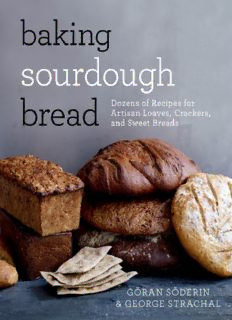
Baking Sourdough Bread: Dozens of Recipes for Artisan Loaves, Crackers, and Sweet Breads PDF
Preview Baking Sourdough Bread: Dozens of Recipes for Artisan Loaves, Crackers, and Sweet Breads
Contents The Mystical Sourdough The Chemistry The Ingredients The Process Before You Start The Golden Rules A Note on Conversions Making a Sourdough Rye Sourdough Wheat or Spelt Sourdough Oat Sourdough Potato Sourdough Lentil Sourdough Wild Yeast Storing Sourdough Recipes Bread with Wheat Sourdough Bread with Rye Sourdough Crispy Bread Sourdough Breads with Oats, Potatoes, and Lentils Sweet Sourdough Bread Index Acknowledgments The Mystical Sourdough Sourdough is a divine creation—at least, if you believe what the Bible says about it: “The kingdom of heaven is like unto leaven, which a woman took, and hid in three measures of meal, till the whole was leavened” (Matthew 13:33). The Israelites fled Egypt in a hurry. They didn’t have enough time to let the bread rise, meaning they had to bake unleavened bread. Jews celebrate this during the Feast of Unleavened Bread, Hag HaMatzah, during which you eat matzo—a flat bread baked with flour, oil, salt, and water—for a period of seven days. When Emperor Augustus ruled the Roman Empire (around the time of the birth of Christ), Rome had over three hundred bakeries that supplied bread to its citizens—bread that was mainly baked with leaven. The largest bakery produced over 100,000 loaves a day. When the Roman Empire collapsed, the major supply bakeries did as well. We don’t know much about what happened next. There are few records that tell us of the significance of bread over the years; however, recipes have been found from thirteenth-century monasteries. According to American literature, the Wild West could never have been conquered without sourdough starters, and the old veterans of Alaska— prospectors and settlers—were called “sourdoughs.” They always carried a bit of sourdough in their knapsacks or in a bag that hung from a ribbon around their necks. Unlike yeast, sourdough could keep for long periods of time. You would bring it from home with you in order to obtain the specific taste of the bread you grew up with. Being called “sourdough” was proof of manhood. It meant that you were tough, experienced, and hardened. Sourdough was valued so highly that it was preserved in the family as if it were worth its weight in gold. Primarily in the United States, the culture around sourdough has created a variety of modern myths. One of the most mystical sourdough cultures is called “The San Francisco Sourdough,” and it is made from a lactic acid bacterium called Lactobacillus sanfransiscensis. Other types of dough have also been praised in modern sourdough history; these include the German Sauerteig, the Russian Zakvaska, the Flemish Desem, and the French Levain.
Description: